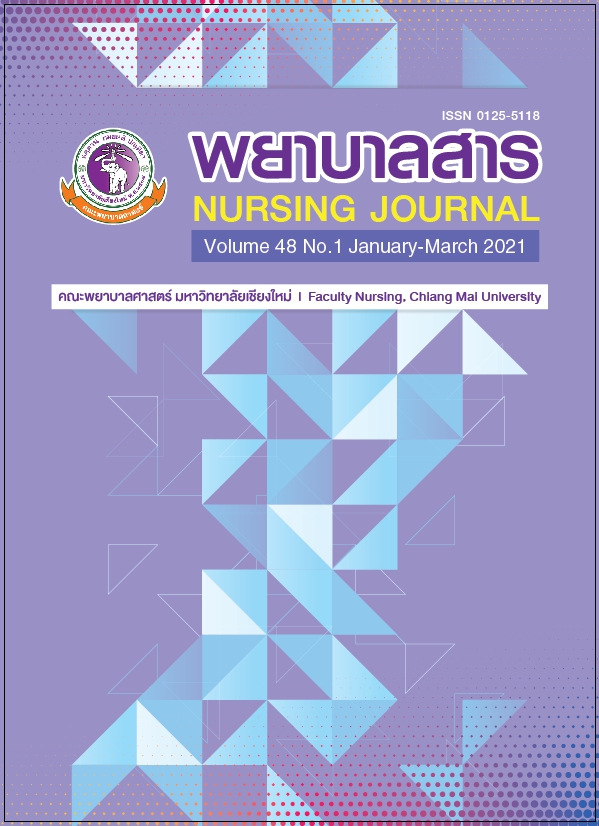The Effect of Readiness Pattern for Patients Undergone General Anesthesia On State Anxiety in Srisangwornsukhothai Hospital Sukhothai Province
Keywords:
Readiness Pattern, Patients Undergone General Anesthesia, State AnxietyAbstract
State-anxiety is an emotional state that occurs at the time of stimulating events, that affect the thought process and the perception of the person changes. Especially surgery, in which most patients assessed as a life crisis and anxiety-inducing situation. Nurses Anesthetists' role is patient preparation by providing information and knowledge related to surgery and anesthesia in reducing anxiety in helping patients decide to face different situations. This research is a quasi-experimental study. The aim was to compare the state anxiety levels in patients undergoing general anesthesia before and after receiving the readiness pattern with traditional education. The sample consisted of 64 patients who received surgery undergoing a general anesthesia was divided into a control group and a experimental group of 32 participants. 1) The control group was prepared before undergoing general anesthesia according normal anesthesia standards. 2) The experimental group was prepared using the readiness pattern of care for patients undergoing general anesthesia that the researcher created. Both groups were assessed for anxiety using the State-Trait Anxiety Inventory [STAI] form Y-1) before and after providing information on preoperative preparation.
The results showed that the experimental group had mean scores for state anxiety before and after receiving the readiness pattern of care for patients undergoing general anesthesia of 43.12 ± 5.29 and 37.03 ± 4.91 respectively. The control group had mean scores for state anxiety before and after receiving normal anesthesia standards of 44.93 ± 4.46 and 48.15 ± 2.81 respectively. Prior to the implementation, the patients in both the control and experimental groups had no significant difference in scores of state anxiety scores, p = 0.810. After receiving the information, the patients in both groups had significantly lower state anxiety scores, p = 0.002 and p <0.001, respectively. When comparing state anxiety after implementation of both groups, it was found that a group of patients who received the readiness pattern for patients under general anesthesia, there was significantly less state anxiety than the non-receiving group, p = 0.048. Conclusion, the readiness pattern of care for patients undergoing general anesthesia it reduces state anxiety more than conventional preparation.
References
Arumyavas, D., Tribuddhatat, S., Sathitkarnmanee, T., & Palachewa, K. (2012). The Effect of Systematic Anesthetic Informed Consent on Anxiety Level in Patients Undergoing General Anesthesia. Thai Journal od Anesthesiology, 38(2), 102-108. (In Thai)
Auttayasai-ngam, P., & Yeekian, C. (2015). Knowledge, anxiety and options of pre-operation patient watched anesthetic TV chanel. Thai Journal of Anesthesiology, 41(2), 92-102. (In Thai)
Gilmartin, J., & Wright, K. (2008). Day surgery: patients’ felt abandoned during the preoperative wait. Journal of Clinical Nursing, 17(18), 2418-1425. https://doi.org/10.1111/j.1365- 2702.2008.02374.x
Gulrach, V., Kunsongkeit, W., & Duangpaeng, S. (2017). Factors Related to Preoperative Anxiety among Patients with Eye Surgery. Boromarajonani College of Nursing, Uttaradit Journal, 9(1), 1-12. (in Thai)
Hongvilai, K. (2014). The Outcomes of Readiness Pattern for Patients Undergone Anesthesia. (Unpublished Master Dissertation). Nakornpathom: Christian University. (In Thai)
Jimarsa, L. & Changjeraja, W. (2020). The Effect of Preoperative Preparatory Program on Anxiety and Complications in Patients Underwent Cataract Surgery in Ophthalmology Clinic at Bueng Kan Hospital. Academic Journal of Mahasarakham Provincial Public Health Office, 4(7), 75-87. (In Thai)
Kochapakdee, N., Worakitpokat, S., & Nisaisuk, M. (1988). Anxiety Assessment. Bangkok. (In Thai)
Leventhal, H., & Johnson, J. E. (1983). Laboratory and field experiment of a theory of self-
regulations. In P.J. Wooldridge, M.H. Schmitt, J.K. Skipper, & R.C. Leonard (Eds.), Behavioral science and nursing theory (pp.189- 262). St. Louis: Mosby.
Liddle, C. (2012). Preparing patients to undergo surgery. Nursing Times, 108(48), 12-3.
Nigussie, S., Belachew, T., & Wolancho, W. (2014). Predictors of preoperative anxiety among surgical patients in Jimma University Specialized Teaching Hospital, South Western Ethiopia. BioMed Central Surgery, 14(67), 2-10.
Nittayasupaporn, S., Kaewnimitchai, N., & Namjuntra, R. (2014). Thai Journal of Cadio-Thoracic Nursing, 25(1), 3-15.
Nursing Division, Ministry of public Health. (2011). Quality of Nursing: Quality Assessment (2nd ed.). Bangkok: Sam Charoen Phanich Company Limited. (In Thai)
Polit, D.F., & Beck, C.T. (2014). Essentials of nursing research: Appraising evidence for nursing practice (8th ed.). Philadelphia, PA: Lippincott Williams & Wilkins.
Pituksung, A., Tanterothum, J., Supharerx, S., & Waranukulsak, O. (2011). The study of anxiety, stress and information required of the preoperative outpatients. Siriraj Nursing Journal, 4(1), 39-42. (in Thai).
Satayathum, C. (2011). Psychiatric and mental health nursing (11th ed). Nonthaburi: Boromarajchanok Welfare Institution Program. (in Thai)
Sathusen, A. (2011). Research report on Knowledge, Attitudes and Patient Satisfaction Towards Preparation before Receiving Anesthesia. Prachinburi: Chaophraya Abhaibhubejhr Hospital. (In Thai)
Srisangwornsukhothai Hospital. (2019). Annual Report 2019. Sukhothai: Srisangwornsukhothai Hospital.
Srisatidnarakul, B. (2010). The Methodology in nursing research (5th ed.). Bangkok: U and I Intermedia.
Spielberger, C.D. (Ed.). (1966). Anxiety and behavior. Academic Press.
Spielberger, C.D., Corsuch R.L.& Lusheue R.E. (1970). STAI Manual. California: Consulting Psychologists Press.
Techawiboonphol, K., Khwamkhnung, J., Thanakit, A., & Eupairojkit, K. (2011). Explained for
Anxiety in Women waiting for Caesarean Section, A Randomized Controlled Trial. Thai Journal of Anesthesiology, 37(2), 71-79. (In Thai)
Thuchart, S., Asdornwised, U., Pinyopasakul, W., & Trakarnsanga, A. (2019). The Effects of Concrete-Objective Information Program on Pre-Operative Anxiety in Abdominal Surgery Patients. Nursing Science Journal of Thailand, 37(2), 78-91. (In Thai)
Well, J., Howard, G., Nowlin, W., & Vargas, M. (1986). Presurgical anxiety and postsurgical pain and adjustment: Effect of a stress inoculation procedure. Journal Consult Clinical Psychology, 831-835.
Downloads
Published
How to Cite
Issue
Section
License
บทความที่ได้รับการตีพิมพ์เป็นลิขสิทธิ์ของวารสารพยาบาลสาร
ข้อความที่ปรากฏในบทความแต่ละเรื่องในวารสารวิชาการเล่มนี้เป็นความคิดเห็นส่วนตัวของผู้เขียนแต่ละท่านไม่เกี่ยวข้องกับมหาวิทยาลัยเชียงใหม่ และคณาจารย์ท่านอื่นๆในมหาวิทยาลัยฯ แต่อย่างใด ความรับผิดชอบองค์ประกอบทั้งหมดของบทความแต่ละเรื่องเป็นของผู้เขียนแต่ละท่าน หากมีความผิดพลาดใด ๆ ผู้เขียนแต่ละท่านจะรับผิดชอบบทความของตนเองแต่ผู้เดียว






